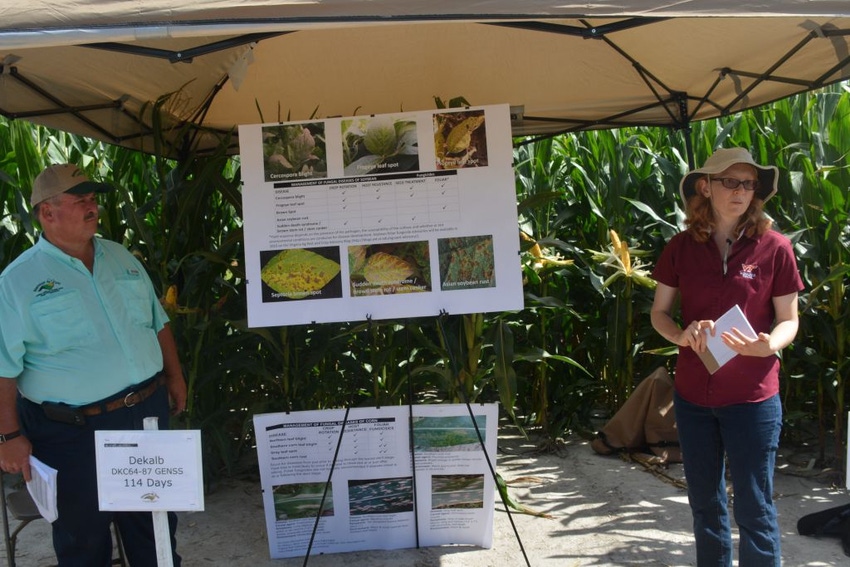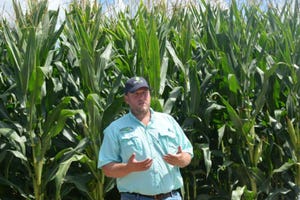
The importance of disease management to maximize corn yields and ongoing concern about Palmer amaranth topped discussion at the 2015 Northeast Ag Expo Field Day in Shiloh, N.C. July 30.
Traveling south from Virginia, Hillary Mehl, Extension crops plant pathologist at Virginia Tech, stressed the importance of knowing the relative resistance or susceptibility to diseases of each corn variety selected. Through it all, farmers must be aware of the disease they are looking for, which is why scouting is critical, Mehl emphasized.
Ideally, Mehl said, farmers should seek varieties that have some resistance or tolerance to diseases. But that isn’t always possible because sometimes high yielding varieties with good agronomic characteristics don’t offer good disease resistance. Scouting is job one, she said.
“We don’t have every disease in every field every year so scout your fields to see if and when a disease shows up,” Mehl advised “If it’s not there, you may not need to apply a fungicide, but if certain diseases are there during certain growth stages of the plant, you want to consider a fungicide application.”
Protecting the crop from diseases is most critical between grain development and grain filling to achieve maximum yields, Mehl stressed.
“Varieties that mature later or that you plant later are going to be exposed to more fungal inoculum because there has been more time throughout the season for these diseases to spread and develop in the environment,” she said.
“Timing of fungicides is important. The most important time to protect your yield is during grain development. In general, the best time to apply a fungicide is around the tasseling growth stage, from the late vegetative growth stages to the early reproductive stages,” she added.
If a farmer decides to apply a foliar fungicide, determining the proper chemistry for disease control is critical, depending on the disease that is present, Mehl said.
Crop rotation is also vital, Mehl stressed. “You are more likely to have certain diseases if you have corn year over year. Many diseases, such as Northern leaf blight, Southern corn leaf blight and gray leaf spot, over winter on corn debris,” she said. “That’s not the case for Southern corn rust. That disease doesn’t survive the winter in our area.”
Mehl said the diseases most likely needed to be controlled with fungicides are gray leaf spot and southern corn rust, if it moves into the area when corn is still in the period of grain filling.
“Scout for disease from just prior to silking through the kernel dent stage,” she advised. “Yield loss is most likely to occur if a disease is observed at or just after silking. Foliar fungicides are not typically recommended if disease onset is at or following the dent stage.”
In what he termed the “gloom and doom” part of the tour, Wes Evernman, Extension weed management specialist with North Carolina State University, said ppo-resistant palmer Amaranth has popped up in North Carolina.
“It seems like it’s showing up pretty widespread this year,” Evernman said. “At first, I was hoping it was because we had a lot of hot, dry weather and the weeds got a way a little. But it looks like we may have a real game changer when it comes to resistance.”
For example, Evernman said a farmer near Rockingham, just north of the South Carolina border, sprayed a PPO inhibitor on his soybeans twice this year. He applied 16 ounces of Cobra per acre on the first application and two weeks later, he applied a second 16 ounce application of Cobra when he realized it didn’t kill the palmer Amaranth at the first application.

Wes Everman, Extension weed management specialist with North Carolina State University, says farmers need to be more proactive in palmer Amaranth control.
“The pigweeds were growing like they’ve never been sprayed,” Everman said.
Everman said the ppo- resistant pigweed problem points to the need for different modes of action for control. Rotation of corn with soybeans remains one of the best management practices for palmer Amaranth control in North Carolina, Everman emphasized. The use of soil-applied products is also needed, he said. In addition, the use of growth regulators and HPPD-inhibiting herbicides are important, particularly on heavier soils. HPPD inhibitors aren’t as effective on lighter soils, Everman noted.
“We need to be a lot more proactive. We need to stay ahead of the game and do a little more planning and make sure we incorporate multiple modes of action every time we go out. We need to try to stay ahead of it and avoid developing resistance,” he said.
About the Author(s)
You May Also Like






